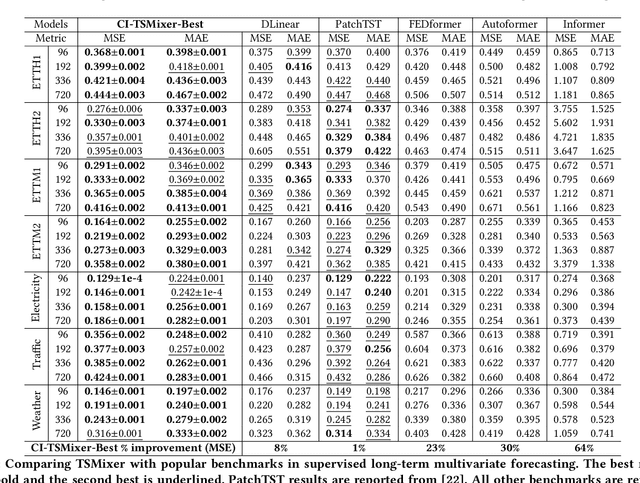Phanwadee Sinthong
TSMixer: Lightweight MLP-Mixer Model for Multivariate Time Series Forecasting
Jun 28, 2023



Abstract:Transformers have gained popularity in time series forecasting for their ability to capture long-sequence interactions. However, their high memory and computing requirements pose a critical bottleneck for long-term forecasting. To address this, we propose TSMixer, a lightweight neural architecture exclusively composed of multi-layer perceptron (MLP) modules. TSMixer is designed for multivariate forecasting and representation learning on patched time series, providing an efficient alternative to Transformers. Our model draws inspiration from the success of MLP-Mixer models in computer vision. We demonstrate the challenges involved in adapting Vision MLP-Mixer for time series and introduce empirically validated components to enhance accuracy. This includes a novel design paradigm of attaching online reconciliation heads to the MLP-Mixer backbone, for explicitly modeling the time-series properties such as hierarchy and channel-correlations. We also propose a Hybrid channel modeling approach to effectively handle noisy channel interactions and generalization across diverse datasets, a common challenge in existing patch channel-mixing methods. Additionally, a simple gated attention mechanism is introduced in the backbone to prioritize important features. By incorporating these lightweight components, we significantly enhance the learning capability of simple MLP structures, outperforming complex Transformer models with minimal computing usage. Moreover, TSMixer's modular design enables compatibility with both supervised and masked self-supervised learning methods, making it a promising building block for time-series Foundation Models. TSMixer outperforms state-of-the-art MLP and Transformer models in forecasting by a considerable margin of 8-60%. It also outperforms the latest strong benchmarks of Patch-Transformer models (by 1-2%) with a significant reduction in memory and runtime (2-3X).
A Time Series is Worth 64 Words: Long-term Forecasting with Transformers
Nov 27, 2022Abstract:We propose an efficient design of Transformer-based models for multivariate time series forecasting and self-supervised representation learning. It is based on two key components: (i) segmentation of time series into subseries-level patches which are served as input tokens to Transformer; (ii) channel-independence where each channel contains a single univariate time series that shares the same embedding and Transformer weights across all the series. Patching design naturally has three-fold benefit: local semantic information is retained in the embedding; computation and memory usage of the attention maps are quadratically reduced given the same look-back window; and the model can attend longer history. Our channel-independent patch time series Transformer (PatchTST) can improve the long-term forecasting accuracy significantly when compared with that of SOTA Transformer-based models. We also apply our model to self-supervised pre-training tasks and attain excellent fine-tuning performance, which outperforms supervised training on large datasets. Transferring of masked pre-trained representation on one dataset to others also produces SOTA forecasting accuracy. Code is available at: https://github.com/yuqinie98/PatchTST.
 Add to Chrome
Add to Chrome Add to Firefox
Add to Firefox Add to Edge
Add to Edge